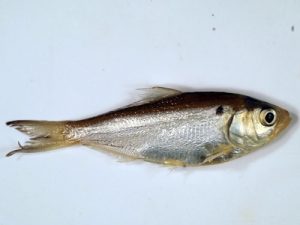
Although not native to the Mid Atlantic states, threadfin shad have been introduced in lakes and reservoirs throughout the region. They are usually stocked as forage for larger fish such as landlocked striped bass, largemouth bass, musky, and walleye.
Threadfin shad are silver-blue above, with whitish undersides and yellow-tinted fins (except the dorsal). Adult threadfin typically reach lengths of 6 inches. Threadfin shad can be distinguished from gizzard shad by several features. Adults are usually smaller than gizzard shad. The upper jaw of threadfin shad does not project beyond the lower jaw as it does in gizzard shad. Threadfin also have black speckling around the chin and lower mouth which is lacking in gizzard shad.
Threadfin shad prefer areas where currents occur and are usually found near the surface. They are temperature sensitive and sometimes die in large numbers when water temperatures fall below 45°F.
In large lakes and reservoirs, threadfin shad are often used as live baits. They can be purchased in lake side tackle shops or caught with cast nets. When fishing with live shad, specialized tackle and equipment is essential.
Bait containers are essential for keeping shad alive and healthy. These range from simple bait buckets to in-boat live wells. Live well or bait tank water must be re-circulated and oxygenated via pump or bubbler systems.